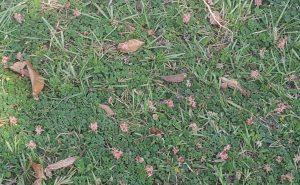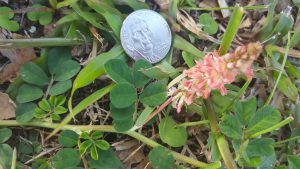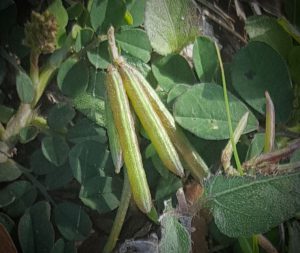It is extremely difficult to control something when you don’t know what it is! We can’t make an effective herbicide recommendation or cultural activity recommendation without knowing what plant/weed we are dealing with. But how do you find out? You have some options!
Take a Picture!
 Not just any picture though! Try a long shot – showing the whole area where the weed is located. This tells us something about the weed’s growth habit and other possible characteristics like the picture to the right we see it is in a pasture or lawn. Then the next picture should be a close up with some type of size scale.
Not just any picture though! Try a long shot – showing the whole area where the weed is located. This tells us something about the weed’s growth habit and other possible characteristics like the picture to the right we see it is in a pasture or lawn. Then the next picture should be a close up with some type of size scale.
When I take a photo for scale I typically use something we can all relate to. See in the picture below, which is a close up and it provides a nickel to show the size of the plant in comparison. A ruler will work as well but you may not have one of those with you in the field. So use what you do have, pocket change, a dollar bill, maybe even a 5 gallon bucket.

This is creeping indigo and not only does the nickel show us the leaf size but also the flower size and I can see the plant is running along the ground. A picture really does provide a lot of information that a mere description does not. One problem with the close up picture is it did not have the seed pods in it which also helps with ID.

Dig:
If you don’t have a camera handy or a camera on your phone then dig the plant up or get a good sample of it. Try and get the root system if it is a small sized plant or if it is too large or a tree take a small limb with a flower if possible. Do not bring in a single leaf or blade, those will not typically allow for a positive identification. If there are flowers try not to damage them.
Once you have the plant you need to keep it “as is” meaning try and keep it moist and out of the heat. Don’t put it on the dash until you get to town to give it to me or whomever is going to identify it for you. Place the sample in a bag if you have one and place a moist paper towel around the root or base if you can. This is why both a picture and a fresh plant sample is preferred! The combination really allows us to see the whole picture without a visit. Which leads me to the next option.
Field Visit:
As an Agriculture Extension Agent a field visit is what I call our bread and butter! We like being in the field and seeing first-hand the situation! Many times while there we can assess the surroundings and the whole situation which can lead to maybe even better weed control for you, not just the identification of a plant! (Due to current travel restrictions, we are not traveling but you can email or call.)
Plant ID:
The final step is the actual identification. There are several methods to help with identification: UF/IFAS herbarium, books, weed guides, internet search, neighbor, Master Gardener,etc.etc. I recommend IFAS’s Bookstore (ifasbooks.ufl.edu)
There are several books and identification photo decks available. Once the plant is positively identified we can then offer the correct herbicide to control the problem weeds.
In conclusion there are several UF/IFAS Extension websites that can offer you more assistance with collecting samples, identification and even recommendations:
edis.ifas.ufl.edu (Extension publications)
plants.ifas.ufl.edu (Center for Aquatic and Invasive Plants)
ddis.ifas.ufl.edu (Distance Diagnostic and Identification System)
Or just give us a call we are happy to help!
 0
0
